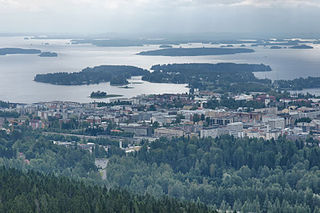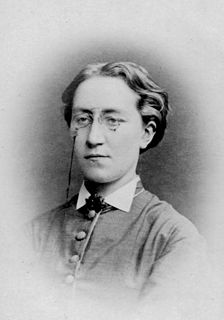Alma Hjelt (1853-1907), was a Finnish gymnast and women's rights activist. In 1884, she became the first chairperson of the first women's organisation in Finland.

Finland, officially the Republic of Finland is a country in Northern Europe bordering the Baltic Sea, Gulf of Bothnia, and Gulf of Finland, between Norway to the north, Sweden to the northwest, and Russia to the east. Finland is a Nordic country and is situated in the geographical region of Fennoscandia. The capital and largest city is Helsinki. Other major cities are Espoo, Vantaa, Tampere, Oulu and Turku.
She was the daughter of the politician Nils Hjelt. In 1884, the Suomen Naisyhdistyksen , the first organisation for women's rights were founded in Helsinki in Finland by Alexandra Gripenberg, and Alma Hjelt became its first chairman. The purpose of the organisation was to work for access of the same cultural and political rights for women as for men. After 1886, branches of the organisation was founded in other parts of Finland, the first being the one in Kuopio headed by Minna Canth.

Helsinki is the capital city and most populous municipality of Finland. Located on the shore of the Gulf of Finland, it is the seat of the region of Uusimaa in southern Finland, and has a population of 648,650. The city's urban area has a population of 1,268,296, making it by far the most populous urban area in Finland as well as the country's most important center for politics, education, finance, culture, and research. Helsinki is located 80 kilometres (50 mi) north of Tallinn, Estonia, 400 km (250 mi) east of Stockholm, Sweden, and 390 km (240 mi) west of Saint Petersburg, Russia. It has close historical ties with these three cities.

Alexandra Gripenberg, also known as Alexandra van Grippenberg, was a Finnish social activist, author, editor, newspaper publisher, and elected politician, and was a leading voice within the movement for women's rights in Finland at the turn of the 20th century. She was also known as a Fennoman.

Kuopio is a Finnish city and municipality located in the region of Northern Savonia (Pohjois-Savo). It has a population of 118,434, which makes it the ninth-most populous city in Finland. Kuopio has a total area of 4,326.35 square kilometres (1,670.41 sq mi), of which 719.85 km2 (277.94 sq mi) is water and half is forest. Though the city’s population is a spread-out 74/km2 (190/sq mi), the city's urban areas are populated comparably densely, making Kuopio Finland’s second-most densely populated city.
In her will, she founded a scholarship for females wishing to study medicine; it also provided funds for Finnish females to study medicine abroad, should they in the future be barred from study medicine in Finland.


